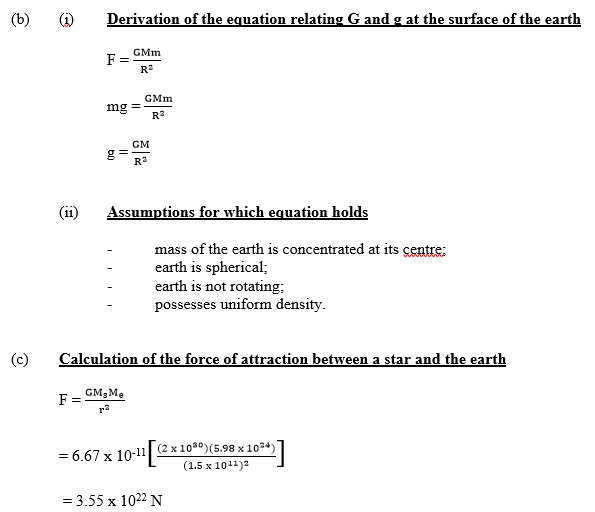Question 8
(a) (i) State Newton’s Law of Universal Gravitation.
(ii) Define gravitational field.
(b) (i) Derive the equation relating the universal gravitational constant, G, and the acceleration of free fall, g, at the surface of the earth from Newton’s law of universal gravitation.
(ii) State two assumptions for which the relationship in 8(b)(i) holds.
(c) Calculate the force of attraction between a star of mass 2.00 x 1030 kg and the earth assuming the star is located 1.50 x 108 km from the earth. [Mass of the earth = 5.98 x 1024 kg; G = 6.67 x 10-11 N m2 kg-2; g = 10 m s-2]
(d) (i) Define escape velocity.
(ii) State two differences between the acceleration of free fall (g) and the universal gravitational constant (G).
Observation
Part (ai) This was one of the popular choice of the candidates but the recorded performance was
fair. Many candidates had no problem with this. However, it is not appropriate to use
“particles” in place of bodies or masses. Those who used particles risked loss of mark. (ii) In
an attempt to define gravitational field, many candidates wrongly presented the definition to
score zero.
Part (bi) a good number of candidates succeeded in deriving the equation. However, those who did
not differentiate the masses lost some marks.
(ii) In response to the question, most candidates were able to recognize that the earth is
spherical but could not think of another correct assumption.
Part (c) Many candidates scored full mark but some who did not convert “km” to “m” lost some
mark. drew the velocity-time graph correctly and determined the total distance travelled but
some were not able to give correct calculation of deceleration. Performance was average.
Part (di) Many candidates defined the term correctly. A few lost the mark for using “maximum
velocity” instead of “minimum velocity”.
(ii) The response to this part was satisfactory.
The expected answer is
(a) (i) Newton’s law of Universal Gravitation
Any two bodies in the universe attract each other with a force
that is (directly) proportional to the product of their masses and
inversely proportional to the square of the distance between them.
(ii) Definition of gravitational field
A region/space in which gravitational force is felt/experienced.

(d) (i) Definition of escape velocity
The minimum uni-directional speed/velocity required by a body to leave the gravitational field/influence of a planet
(ii) Differences between acceleration of free fall (g) and universal gravitational constant (G)
g G
Its unit is N m2 kg-2 Its unit is m s-2 / N kg-1
It is constant everywhere It varies from place to place
It is a scalar quantity It is a vector quantity
| g | G |
| Its unit is N m2 kg-2 | Its unit is m s-2 / N kg-1 |
| It is constant everywhere | It varies from place to place |
| It is a scalar quantity | It is a vector quantity |
